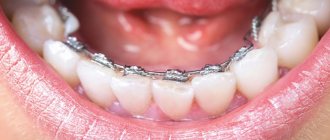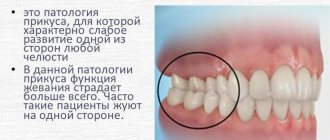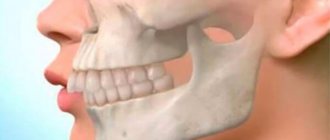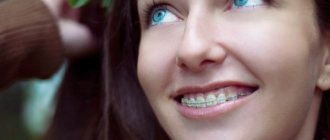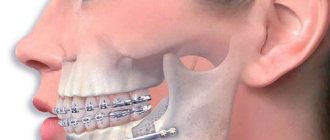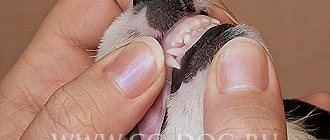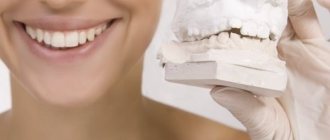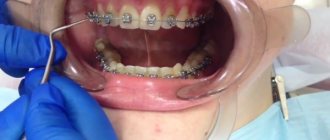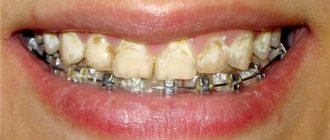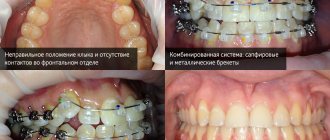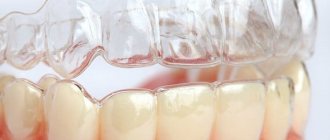527
Correct bite guarantees not only the aesthetic appearance of the oral cavity, but also the health of teeth and other organs.
It is necessary to take care of the correct positioning of incisors, canines and molars when the child’s jaws are growing and developing.
To eliminate existing pathologies, braces are most often used. However, it is important to know at what age they can be installed so as not to cause even more harm to the child’s teeth.
Visit to the orthodontist
The formation of a person’s bite begins at the moment of birth and continues throughout the entire period of teeth growth - first milk, then permanent.
It is important to pay attention to the location of the incisors, canines and chewing teeth relative to each other already during the period of growth of temporary units. This is explained by the fact that deviations in the location of baby teeth with their loss and growth of permanent elements of the row will not disappear; on the contrary, they will worsen.
Most often, the curvature becomes noticeable when all the baby teeth have erupted, the jaws are actively growing and preparations for changing the temporary bite to a permanent one occur.
According to most dentists, the first visit to the orthodontist should be at the age of 6-7 years.
In some cases, you should seek specialist advice earlier. The following factors may be the reason for this:
- both parents have malocclusion;
- presence of bad habits - sucking pacifiers and fingers;
- predisposition to central nervous system diseases and fluctuations in blood sugar levels;
- nasal breathing disorder.
A preventive examination of a child by an orthodontist should be carried out even in the absence of visible defects of the jaw row. A specialist can prescribe the necessary examinations, identify the problem at the formation stage, and advise ways to solve it.
Generus miniature braces and their characteristics.
Come here if you are interested in whether they accept braces into the army.
At this address https://www.vash-dentist.ru/ortodontiya/breketyi/luchshe-ustanavlivat-na-2-chelyusti.html we will find out why it is better to install braces on 2 jaws.
Treatment planning
It is necessary to begin correcting a defective bite at the moment the pathology is detected. Correction methods depend on the age of the child.
In children under 9-10 years of age, therapy is carried out using removable devices - plates and trainers. They actively influence muscle restructuring and form the correct development of bone tissue.
According to dentists, the optimal time to install braces comes after the child’s second molars erupt, which occurs at 14-15 years of age.
If the system is installed before this point, tooth growth may occur outside the jaw arch, which will require correction in the future.
Fixation of the bracket system is preceded by a number of preparatory procedures:
- Examination by a dentist. The specialist conducts a thorough examination to determine the condition of the teeth and gums and identify diseases of the oral cavity that need to be eliminated before proceeding with bite correction.
- Sanitation of the oral cavity. Based on the results of the examination, the doctor carries out the necessary therapeutic measures - instrumental teeth cleaning, treatment of caries, elimination of gum diseases.
- Orthodontist consultation. At this stage, a specialist examines the child’s oral cavity and makes a decision on what type of braces should be installed to obtain results in a short time.
- Instrumental examination. An orthopantomogram and teleroentgenogram are performed to assess the position of the jaws relative to each other, the position, displacement and inclination of the teeth, and the type of bite pathology.
- Making an impression of the jaw. Based on the impression obtained, a plaster model is made, which serves as the basis for the manufacture of an individual bracket system.
Design selection
Fixed systems for bite correction can differ greatly from one another. The difference lies in the use of different materials for their manufacture, fixation of locks and a power arc.
The choice of a specific type of design depends both on the wishes of the child and on the complexity of the pathology that needs to be eliminated.
By material
The clasps of a non-removable brace system used to correct bites in children can be made from the following materials:
- Medical hypoallergenic steel .
The advantages of metal products are their high strength, reliability in operation, and reduced treatment time compared to more plastic structures. Such braces may be ligated or not have a ligature. The main disadvantage of the system is its unesthetic appearance, which is quite important for children. This problem can be eliminated by using colored locks and ligatures. - Plastic .
Plastic structures have a large number of disadvantages - they are not strong enough, have a porous structure and a short service life. Among the advantages of braces are their aesthetic appearance and low cost. It is advisable to use such systems for minor, easily removable bite pathologies. - Ceramics .
Ceramic clasps are almost invisible on the surface of the teeth; only the power arc stands out, the color of which can be chosen in accordance with the child’s wishes. The bracket system is durable and reliable in operation, but requires careful maintenance and is expensive.
By fixing the arc
Depending on the method of fastening the power arc, ligature and non-ligature bracket systems are distinguished.
The ligature is a thin metal wire or rubber band that secures the power arc in the grooves of the locks.
Ligature braces put a lot of pressure on the teeth that require correction, so their use is recommended at the beginning of orthodontic treatment.
The disadvantage of this type of system is the need to regularly visit the dentist to replace the ligatures and arches.
Self-ligating braces are systems with free sliding of the arch in the grooves. The design is effective for minor bite defects. It puts less pressure on the tooth surface, resulting in no severe pain.
Both types of braces require a timely visit to the orthodontist to monitor the process of correcting the bite and correcting the position of the power arch.
By location
Fixation of clasps on the tooth surface can be carried out from the lips - vestibular braces, and from the tongue - lingual braces. Both options have advantages and disadvantages.
Vestibular braces can eliminate more complex malocclusion pathologies, have a shorter treatment duration and are lower in cost . The main disadvantage is the visibility of the structure during communication and eating.
The lingual system is practically invisible to others, but has a large number of contraindications.
The design cannot be used in cases of high crowding of teeth and small width of the jaw row. Locks attached to the inner surface of the teeth can damage the mucous membrane of the gums and tongue and negatively affect the child’s diction.
The cost of vestibular braces is lower than lingual braces.
Learn more about how braces are removed and how painful it is.
This article contains everything you need to know about activating braces.
Here https://www.vash-dentist.ru/ortodontiya/breketyi/vidyi-nadkusochnyih-plomb.html read how to chew with bite fillings.
Differences in braces by material
Bracket systems, depending on the material, can be divided into several types. Let's describe the most popular ones.
Metal braces
Made from an alloy of metal and titanium. They are considered the most affordable in terms of price. Thanks to the properties of titanium, they can easily withstand any loads that arise when forming the correct position of the jaw system. The aesthetic component of such braces leaves much to be desired, and therefore many children refuse to wear them. But in this case, shaped and colored braces can come to the rescue. To make the braces multi-colored, rubber bands of different shades are used. Self-regulating systems are much easier to make curly, which also explains their choice among children.
Ceramic bracket systems
Ceramic systems can be self-regulating and ligature. In terms of strength, ceramics are comparable to metal, but strength is not its least advantage. The color of the clasps of such devices wonderfully replicates the natural shade of tooth enamel, which means that there is every chance that these designs will be completely invisible when worn.
Sapphire braces
They are also considered invisible, but unlike ceramic devices, they do not match the shade of tooth enamel, but are completely transparent. Of course, in terms of their characteristics, such as ease of care, ease of use, and quick results, they are rightfully considered the best. But they are installed very rarely for children due to their high cost. If we compare their price with classic metal structures, it is several times higher.
Plastic braces
The most economical option, but they are used only when correcting minor defects in the dental system. They do not have sufficient strength, are not durable, and last a maximum of a year. Upon reaching this period, plastic structures lose color and begin to crack, as a result of which they require replacement. This is very inconvenient and will require additional financial expenses if the treatment period is extended.
Nuances of fixation
Bite correction in children under 5 years of age can be performed using special removable plates and trainers . Minor malocclusion pathologies detected at this age are quickly eliminated due to the active growth of the skull bones.
At the age of 7-9 years, the installation of braces is undesirable, as it can lead to serious damage to the enamel. However, if there are important medical indications, the dentist may recommend starting orthodontic treatment with the selection of the most suitable design.
Before deciding whether to install braces, dentists evaluate the following factors:
- the presence of erupted second molars - in their absence, it is pointless to begin bite correction;
- root formation;
- absence of muscular imbalance of the oral cavity – underdevelopment of the muscles of the oral cavity requires correction with the help of special orthodontic structures;
- condition of the enamel - if it is not sufficiently formed, fixing the clasps can cause the development of caries.
If all of the above conditions are met, the specialist begins fixing the bracket system. This is done as follows:
- A special expander is fixed in the child’s oral cavity , thanks to which the specialist gains access to all elements of the jaw.
- The teeth are dried from moisture, after which a special liquid containing orthophosphoric acid is applied to them. This ensures strong adhesion of the locks to the enamel.
- The acid-containing mixture is washed off the teeth. Next, the enamel is covered with a special composite material that will hold the braces in the right places.
- The clasps of the orthodontic structure are coated with glue and fixed to the tooth surface. After all brackets are placed, the power arch and ligatures are attached.
The video presents expert opinions on age restrictions for installing braces.
Optimal age for braces
Depending on how severely the jaw structure is damaged, the best time to correct the bite will depend. The most effective treatment results are achieved in childhood.
But there are nuances here:
- At 7-9 years of age, correction can begin if the violations are already obvious and further waiting will lead to more serious problems. But such a decision is made only by an orthodontist based on an assessment of the child’s condition. His first permanent upper incisors should have already erupted and grown to a length that will allow him to fully secure the structure. But this age is quite dangerous for wearing braces due to the fact that in this case it is easy to damage children's enamel.
- When the child is already 11 or even 13 years old. This is a more favorable period for treatment, since teeth are still easy to correct, and it is more difficult to harm them. Active growth of the jaw at this time makes it possible to significantly influence what position the units will take and form an ideal smile.
In order not to miss the necessary period for treatment, it is necessary to take the baby to a specialist at the age of 3-4, who will assess the general condition of the teeth and the position of the jaws. The doctor will also give recommendations on nutrition, daily routine and tell you how to correct defects, if any.
The dentist makes a decision about bite correction and the best time to do it, depending on the complexity of the problem, the general development of the child and the natural state of the enamel surface.
Useful tips
During orthodontic treatment, your teeth require especially careful care. Due to their age, children are not always able to provide it, so parents should monitor compliance with the following requirements:
- regular removal of bacterial plaque from the surface of teeth and locks, which will prevent the development of caries;
- the absence in the child’s diet of a large number of products that can damage the system - chewing gum, toffees, candies, seeds, crackers;
- timely visit to the orthodontist to correct the position of the power arch and ligatures - depending on the type of structure, visits may be required every 2-4 weeks;
- Immediate contact with a specialist in case of damage to the elements of the bracket system - unsticking of the clasps, detachment of the ligature.
It is important for parents to explain to their child that for the first time after fixing the braces, there may be a feeling of discomfort, pain, and distortion in the pronunciation of sounds, which will disappear over time.
Another important point that requires discussion is the need to wear orthodontic retainers after removing braces. This will help the teeth stay in their new position without moving back to their previous positions.
What types of braces are there for children?
All children's braces can be divided into several types - self-adjusting and ligature.
Ligatures. Speaking about braces that contain ligatures, it is necessary to mention that such designs are traditional, since they have been used in orthodontics for a relatively long time. What is a ligature? A ligature is essentially a ring with a high degree of elasticity. It is this (sometimes, depending on the model of the device, rubber bands are used instead of a ring) that connects the arc to the locks. Due to this type of fastening, the arch does not have the opportunity to move in the oral cavity. Due to this, an increased load is created on a certain area of the jaw, allowing the teeth to move in the desired direction. Despite the fact that therapy with these braces is considered more effective, self-adjusting structures are chosen for treating children's teeth.
Unligated. They do not have ligatures; the correction arch is fastened using special locks. It is thanks to mini-locks with grooves that the system, under the load created by elastic arches, is able to move to a certain area of the jaw system. At the same time, throughout the entire period of wearing, a uniform load will be distributed on the teeth. The appearance of pain in the first days of wearing braces is not a rare occurrence. After 10-15 days, the human body gets used to the presence of a foreign structure in the mouth, and the pain gradually subsides. Although such systems have received the second name “Self-regulating”, they still require periodic adjustment. It consists in maintaining the current tension force of the arc, made of an alloy of nickel and titanium. The adjustment procedure is carried out by the specialist who installed the adjustment device. On average, its frequency is once every 3 months.
Price issue
For most people, installing a brace system is a paid procedure, regardless of whether it is performed in public or private dentistry.
Free orthodontic treatment is provided only for preferential categories of patients - orphans, disabled people, children with genetic disorders.
The cost of installing a bracket system depends on its type:
- A plastic structure will cost 10-15 thousand rubles.
- Metal models - 20-25 thousand.
- For ceramic locks you will have to pay from 40 to 60 thousand rubles.
If you want to be treated with a lingual system, you should understand that the cost will increase approximately 1.5 times.
Reviews
Despite the duration of wearing braces, it is these designs that make it possible to completely eliminate most bite pathologies.
Thanks to the variety of materials and types of designs, you can choose an option that will be almost invisible in the oral cavity.
Have your children had to undergo orthodontic treatment with braces? Share your experience in the comments section of the article.
If you find an error, please select a piece of text and press Ctrl+Enter.
Tags braces for children
Did you like the article? stay tuned
Previous article
How facial features change after orthodontic treatment with braces
Next article
Why can teeth hurt after fixing veneers and what to do?
What are the best “adult” braces according to reviews?
Most adult patients respond positively to lingual braces. They are fixed on the back surface of the teeth and are absolutely invisible to others. This type of braces has the lowest profile: the clasps of the systems are lower than all others, and therefore do not interfere with diction, do not irritate the mucous membranes, and do not scratch the tongue. Adults also often choose non-ligature ceramic braces - they are practically invisible, quite durable and cheaper than sapphire structures. When choosing a vestibular system that is fixed on the front surface of the teeth, it is worth considering that no matter what invisible material its clasps are made of, the orthodontic arch will always be noticeable. Therefore, you can safely choose classic metal braces. Ultimately, preference for a particular design comes down to its price.
